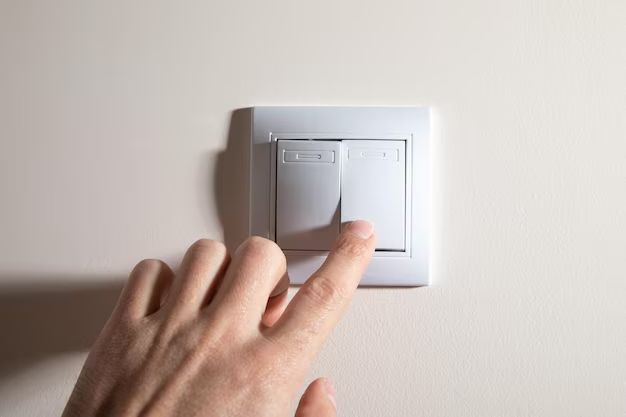Wireless light switches are becoming increasingly popular in homes due to their convenience and flexibility compared to traditional wired switches. But do they actually work reliably? Here is an in-depth look at how wireless light switches work, their advantages and disadvantages, and some guidance on whether they are a good option for your home.
Page Contents
How do wireless light switches work?
Wireless light switches work by transmitting radio frequency (RF) signals to communicate with a main control module and lights/fixtures. Here is a typical setup:
- Wireless light switches – These are battery powered wall units that look like regular light switches. When you press the button, it sends an RF signal.
- Main control module – This is plugged into an electrical outlet somewhere centrally located in the home. It receives signals from the wireless switches.
- Lights/fixtures – These are plugged into electrical outlets and paired with the main control module. They turn on/off in response to signals from the control module.
So when you press a wireless light switch, it sends an RF signal to the control module, which then communicates that signal via RF to the paired lights or fixtures, instructing them to turn on or off. The range is typically 100 feet or more from the control module.
One-way vs two-way communication
Wireless systems use either one-way or two-way communication between the switches and control module:
- One-way – The switches only transmit signals. They do not receive any feedback from the control module. You press a button and hope the paired light got the message. This is less reliable but cheaper.
- Two-way – The switches both transmit to and receive signals from the control module. This allows the switch to provide visual confirmation that the signal was received and the light turned on/off. Two-way systems are more reliable but cost more.
Advantages of wireless light switches
Here are some of the main benefits that make wireless light switches an attractive option:
- Easy installation – No wires need to be run inside walls to each switch. The wireless switches mount easily on the wall surface and can be placed anywhere.
- Flexible placement – Switches can be moved around easily and placed anywhere you want without rewiring.
- No “switch legs” – Wires don’t have to be run from the switch to the light fixture being controlled.
- Retrofitting existing homes – Easily add smart lighting features without running new wires in finished walls and ceilings.
- No batteries in switches – The switches are powered wirelessly from the main control module so no need for batteries.
Disadvantages and challenges
However, there are also some downsides and challenges to keep in mind with wireless technology:
- Limited range/interference – RF signals have a limited range from the control module and can pass through walls and floors. They are also subject to interference.
- One-way reliability – One-way systems have no confirmation that a signal was received, which can lead to missed commands.
- Upfront cost – The initial investment is higher than traditional wired switches.
- Batteries in remote switches – Some systems have battery-powered remote switches which require periodic battery replacement.
- Single point of failure – If the main control module fails, all the switches are affected.
Should you choose wireless or wired switches?
For most existing homes, wireless switches may be the better overall option due to the ability to install without new wiring. However, here are some factors to consider when deciding between wireless vs. wired light switches for your particular situation:
| Wireless | Wired | |
|---|---|---|
| Installation difficulty | Easy, no new wires required | More difficult, wiring required |
| Flexibility of placement | Can place switches anywhere | Limited by existing wiring |
| Reliability | Good but depends on system quality | Excellent, wired connections are very reliable |
| Upfront cost | More expensive | Less expensive for basic switches |
| Ongoing costs | Minimal, no batteries typically needed | None |
For new construction, wired switches may make more sense since wiring is easily installed during building. Though wireless can still be attractive for the flexibility it offers down the road.
What to look for when purchasing wireless light switches
If you decide that wireless light switches are right for your situation, here are some key features to look for when purchasing:
- Two-way communication – Provides reliable signal confirmation
- Name brand with positive reviews – Stick with major brands known for reliability
- 100 ft+ transmission range – Gives more flexibility for switch and module placement
- No battery switches – Avoid switches that require battery replacement
- RF frequency of at least 900 MHz – Higher frequencies handle obstructions better
- Warranty – At least a 1-year warranty on the system
- Support for dimming – Some models support dimming capabilities
Our top wireless light switch recommendations
Based on the criteria above, here are some of the top-rated wireless light switch kits to consider:
| Brand | Model | Key Features |
|---|---|---|
| Lutron | Caseta Wireless Kit | Industry leader, two-way communication, 100 ft. range, dimming capable |
| GE | Wireless Smart Switch Kit | Trusted brand, affordable, one-way communication |
| Leviton | Decora Smart Switch | No battery switches, two-way communication, scheduling options |
Conclusion
Wireless light switches offer homeowners increased flexibility and ease of installation compared to wired switches. However, they have some reliability concerns to consider before choosing them over more traditional wired switches.
Factors like your home construction, budget, and the brand/quality of the wireless system all impact whether they are the right choice for your situation. If selected carefully based on two-way communication, trusted brands, and adequate transmission range, wireless switches can be an excellent lighting control option.
